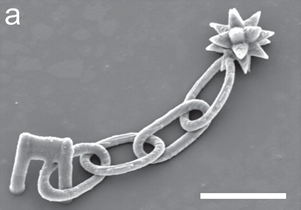Advanced Functional Materials
Multiphoton Lithography of Unconstrained Three-Dimensional Protein Microstructures E. C. Spivey, E. T. Ritschdorff, J. L. Connell, C. A. McLennon, C. E. Schmidt and J. B. Shear, Adv. Funct. Mat., 2013, 23, 333–339.
Abstract Multiphoton lithography (MPL) is a highly versatile strategy for creating 3D microscale objects with complex geometrical arrangements, including nested boxes, interlocking blocks, and braided threads. Of the various chemistries used to produce solid forms in MPL, protein photocrosslinking has been of particular value in biological applications, yielding materials with high porosity, tunable elasticity, and a diverse set of chemical and biochemical properties. Unfortunately, the potential for object drift, and consequent distortion, during this direct-write process has required that microforms be constructed in integral contact with an immobile surface, precluding fabrication of protein-based objects that retain rotational and translational degrees of freedom. Here, the development of a high-viscosity protein-based reagent that can be used to fabricate complex 3D microstructures that are not adhered to a surface, including chains of Möbius strips, paddlewheels, and unconstrained (free-floating) probes for bacterial motility, is reported.
Keywords microstructures; multiphoton lithography; hydrogels; photochemistry; biomedical applications

Multiphoton Lithography of Unconstrained Three-Dimensional Protein Microstructures
